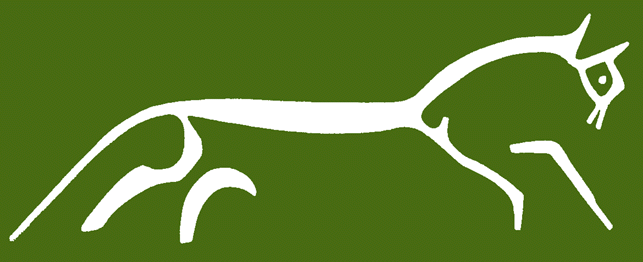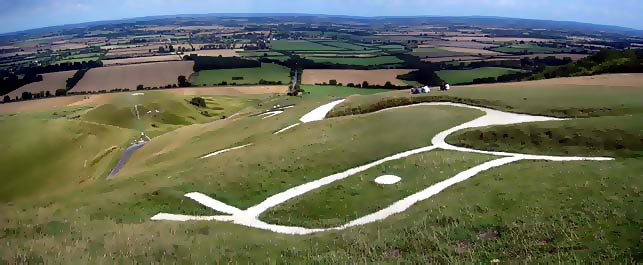|
RBH Home
Maps & Travels
Articles
Legends
Towns & Villages
Castles & Houses
Churches
Biographies
Gentry
Family History
Odds & Ends
For Kids
Teacher's Page
Mail David

|
|

What's it
all about?

- The Uffington White Horse is a
huge white picture of a horse cut into the grassy side of a hill at
Uffington, near Faringdon. This type of picture is
called a hill figure.
- It is over 100 metres long.
That's the length of ten double-decker buses! It can be seen from a
very long way off.
- It doesn't look much like a
horse really. It could be the horse for a 'stick-man', but it has a
strange beak like a bird.
- For centuries, people wondered
how long it had been there. Archaeologists have now used new dating
methods to work out that it is about 3,000 years old! That means it
was carved by Bronze Age people in prehistoric
times.
- They probably came from
Uffington Castle. This is a hillfort right next door. It also dates
from the Bronze Age.
- Horses became very important at
this time because it was when people first started to ride them.
- But why make a big picture of a
horse? Most people think it was the symbol of a prehistoric pagan god.
It is supposed to have magical powers!
- In Iron Age Celtic times,
Uffington Castle was made bigger by a tribe called the Atrebates. They
may have linked the
horse with their sky-god, Beli. His symbol is the wheel (possibly from
a chariot) and he rode a horse.
- A small hill below the horse is
called Dragon Hill. It has a flat top. This might have been an
open-air temple.
- Archaeologists have found that there was no-one living in Uffington
Castle during Roman times. However,
there were still big festivals held there every year. They were
probably to do with the worship of Beli and the horse.
- When everyone became Christian,
they said it was St. George's horse. It had been carved to show that
he had killed the dragon on Dragon Hill.
- There continued to be
celebrations at the horse when it was cleaned every 7 years.
|

|



